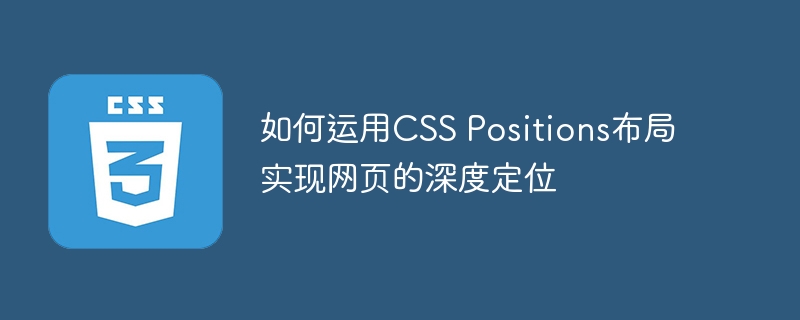

How to use CSS Positions layout to achieve deep positioning of web pages
In web design, depth positioning is an important technical means that can help us accurately position and Layout elements. By using the Positions property of CSS, we can position elements outside the document flow to achieve a more flexible and precise layout effect. This article will introduce how to use CSS Positions layout to achieve deep positioning of web pages, and provide specific code examples.
The Positions attribute includes four values: static (static positioning, default value), relative (relative positioning), absolute (absolute positioning) and fixed (fixed positioning). The following will describe the characteristics of these four positioning methods and how to use them to achieve depth positioning.
Static positioning is the default positioning method of CSS. The position of the element in the document flow is not affected by other positioning attributes and cannot be set. top, right, bottom and left to change its position. Static positioning is generally used for elements that do not require special positioning.
Sample code:
<div class="box">
<p>This is a static positioned element.</p>
</div>
<style>
.box {
position: static;
}
</style>Relative positioning is relative to the initial position of the element in the document flow. You can adjust the position of an element by setting the top, right, bottom, and left attributes, but relative positioning will not change the position of other elements.
Sample code:
<div class="box">
<p>This is a relatively positioned element.</p>
</div>
<style>
.box {
position: relative;
top: 10px;
left: 20px;
}
</style>Absolute positioning is relative to its nearest parent with positioning attributes (non-static) Elements are positioned. If a parent element with a positioning attribute is not found, positioning will be done with reference to the document's initial position. You can precisely control the position of elements by setting the top, right, bottom, and left attributes. Absolute positioning will change the position of other elements, so use it with caution.
Sample code:
<div class="container">
<div class="box">
<p>This is an absolutely positioned element.</p>
</div>
</div>
<style>
.container {
position: relative;
width: 300px;
height: 200px;
background-color: lightgray;
}
.box {
position: absolute;
top: 50px;
left: 50px;
background-color: pink;
}
</style>Fixed positioning is positioned relative to the browser window. Even if the page is scrolled, it is fixed Positioned elements also remain at the specified location. The position of the element can be adjusted by setting the top, right, bottom and left attributes. Fixed positioning is often used to create floating elements, navigation bars and other elements that are fixed on the page.
Sample code:
<div class="fixed-box">
<p>This is a fixed positioned element.</p>
</div>
<style>
.fixed-box {
position: fixed;
top: 50px;
left: 50px;
background-color: lightblue;
}
</style>The above are the four ways of CSS Positions layout to achieve deep positioning of web pages. By flexibly using these positioning attributes, we can easily achieve special layout effects in web pages. I hope the above examples can help you better master and use CSS Positions layout techniques.
The above is the detailed content of How to use CSS Positions layout to achieve deep positioning of web pages. For more information, please follow other related articles on the PHP Chinese website!




